| Listing 1 - 10 of 16 | << page >> |
Sort by
|
Book
ISBN: 0773552693 9780773552692 9780773551282 077355128X Year: 2018 Publisher: Montréal
Abstract | Keywords | Export | Availability | Bookmark
 Loading...
Loading...Choose an application
- Reference Manager
- EndNote
- RefWorks (Direct export to RefWorks)
Montréal (Québec) --- Manrėalʹ (Québec) --- Marianopolis (Québec) --- Mengteli'er (Québec) --- Monrealʹ (Québec) --- Monreāla (Québec) --- Monrealis (Québec) --- Mons Regalis (Québec) --- Mons Regius (Québec) --- Mont-Royal (Québec) --- Montoriōru (Québec) --- Montreali (Québec) --- Monṭreʼol (Québec) --- Montʻŭriol (Québec) --- Mūntiryāl (Québec) --- Ville de Montréal (Québec) --- Μόντρεαλ (Québec) --- Манрэаль (Québec) --- Монреал (Québec) --- Монреаль (Québec) --- Монтреал (Québec) --- מאנטרעאל (Québec) --- מונטריאול (Québec) --- مونتريال (Québec) --- モントリオール (Québec) --- 蒙特利尔 (Québec) --- 몬트리올 (Québec) --- History. --- Social conditions. --- Economic conditions.
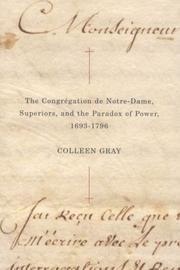
ISBN: 0773578366 1282864629 9786612864629 0773574727 9780773574724 9780773532847 0773532277 9780773532274 0773532846 9780773532847 Year: 2008 Publisher: Montreal [Que.] Chesham [England] McGill-Queen's University Press Combined Academic [distributor]
Abstract | Keywords | Export | Availability | Bookmark
 Loading...
Loading...Choose an application
- Reference Manager
- EndNote
- RefWorks (Direct export to RefWorks)
Gray focuses on the social, administrative, political, and spiritual dimensions of the lives of three Congrégation superiors - Marie Barbier, Marie-Josèphe Maugue-Garreau, and Marie Raizenne. By exploring the implications of the hierarchies of power within the convent and providing a thorough analysis of the convent's relationship with the social, religious, and governmental structures that surrounded it - taking into account both medieval and Catholic Reformation Europe and seventeenth- and eighteenth-century Canada - Gray reveals the paradoxes inherent in the position of a female superior within the male-dominated sphere of both the church and the larger secular community.
Monastic and religious life of women --- Power (Social sciences) --- Superiors, Religious --- Empowerment (Social sciences) --- Political power --- Exchange theory (Sociology) --- Political science --- Social sciences --- Sociology --- Consensus (Social sciences) --- Monastic life --- Monasticism and religious orders for women --- Spiritual life --- Religious superiors --- Christians --- Monasticism and religious orders --- History --- Christianity --- Congregation of Notre-Dame --- CND (Congregation of Notre-Dame) --- Montréal (Québec) --- Manrėalʹ (Québec) --- Marianopolis (Québec) --- Mengteli'er (Québec) --- Monrealʹ (Québec) --- Monreāla (Québec) --- Monrealis (Québec) --- Mons Regalis (Québec) --- Mons Regius (Québec) --- Mont-Royal (Québec) --- Montoriōru (Québec) --- Montreali (Québec) --- Monṭreʼol (Québec) --- Montʻŭriol (Québec) --- Mūntiryāl (Québec) --- Ville de Montréal (Québec) --- Μόντρεαλ (Québec) --- Манрэаль (Québec) --- Монреал (Québec) --- Монреаль (Québec) --- Монтреал (Québec) --- מאנטרעאל (Québec) --- מונטריאול (Québec) --- مونتريال (Québec) --- モントリオール (Québec) --- 蒙特利尔 (Québec) --- 몬트리올 (Québec) --- Religion --- Congrégation de Notre-Dame
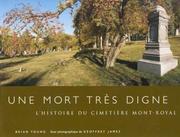
ISBN: 1282861409 9786612861406 077357137X 9780773571372 0773525998 9780773525993 Year: 2003 Publisher: Montréal, Que. McGill-Queen's University Press
Abstract | Keywords | Export | Availability | Bookmark
 Loading...
Loading...Choose an application
- Reference Manager
- EndNote
- RefWorks (Direct export to RefWorks)
Fondé en 1852, le cimetière Mont-Royal est depuis longtemps un espace public cher aux Montréalais. C'est le lieu où sommeillent du repos éternel l'homme politique Sir John Abbott, le poète F.R. Scott, l'étoile du hockey Howie Morenz, l'explorateur David Thompson aux côtés de banquiers, d'apostats, d'un bourreau et de victimes du Titanic. Brian Young nous mène dans le périple captivant de l'histoire sociale du cimetière qui nous révèle son évolution depuis sa naissance en tant que lieu de sépulture rural et protestant, jusqu'à sa condition actuelle de cimetière urbain et multiethnique. L'essai du photographe de renom Geoffrey James capte l'interaction de la beauté et de la mort dans le cimetière.
Protestants --- Burial --- Death --- Dying --- End of life --- Life --- Terminal care --- Terminally ill --- Thanatology --- Burial customs --- Burying-grounds --- Graves --- Interment --- Archaeology --- Public health --- Coffins --- Dead --- Funeral rites and ceremonies --- Grave digging --- Christians --- History. --- Philosophy --- Mount Royal Cemetery (Montréal, Québec) --- Cimetière Mont-Royal (Montréal, Québec) --- Montréal (Québec) --- Manrėalʹ (Québec) --- Marianopolis (Québec) --- Mengteli'er (Québec) --- Monrealʹ (Québec) --- Monreāla (Québec) --- Monrealis (Québec) --- Mons Regalis (Québec) --- Mons Regius (Québec) --- Mont-Royal (Québec) --- Montoriōru (Québec) --- Montreali (Québec) --- Monṭreʼol (Québec) --- Montʻŭriol (Québec) --- Mūntiryāl (Québec) --- Ville de Montréal (Québec) --- Μόντρεαλ (Québec) --- Манрэаль (Québec) --- Монреал (Québec) --- Монреаль (Québec) --- Монтреал (Québec) --- מאנטרעאל (Québec) --- מונטריאול (Québec) --- مونتريال (Québec) --- モントリオール (Québec) --- 蒙特利尔 (Québec) --- 몬트리올 (Québec) --- Social life and customs. --- Mount Royal Cemetery (Montreal, Quebec) --- Montreal (Quebec)

ISBN: 1282858254 9786612858253 0773568034 9780773568037 0773518908 9780773518902 0773518894 9780773518896 9781282858251 6612858257 Year: 2000 Publisher: [Montréal, Que.] Institut d'administration publique du Canada = Institute of Public Administration of Canada
Abstract | Keywords | Export | Availability | Bookmark
 Loading...
Loading...Choose an application
- Reference Manager
- EndNote
- RefWorks (Direct export to RefWorks)
Basing her work on extensive study of Montreal's city records, Dagenais gives us a view of city government from inside city hall, showing how the city's institutions really functioned. From 1900 to 1950, the municipal administration underwent a decisive transformation to become a modern bureaucracy. Dagenais explores the forces behind modernization by illuminating the roles played by city hall's main actors; elected officials, department heads and civil servants. Dagenais presents the municipal government from three perspectives. She first views it as a public administration whose history is marked by the numerous power struggles which brought elected officials into conflict with professional bureaucrats. Secondly, she sees it as a large enterprise which was notably influenced by modern management techniques, and finally she shows it to be a working environment shaped by professional relationships. Dagenais provides the first detailed history of a municipal administration in Canada, one that is particularly important as Montreal was at the economic and financial centre of Canada during this crucial period of urban and industrial development.
Municipal officials and employees --- Civil service, Municipal --- Municipal civil service --- Municipal employees --- Municipal officers --- Town officers --- Civil service --- Local officials and employees --- Public officers --- Labor unions --- Montréal (Québec) --- Manrėalʹ (Québec) --- Marianopolis (Québec) --- Mengteli'er (Québec) --- Monrealʹ (Québec) --- Monreāla (Québec) --- Monrealis (Québec) --- Mons Regalis (Québec) --- Mons Regius (Québec) --- Mont-Royal (Québec) --- Montoriōru (Québec) --- Montreali (Québec) --- Monṭreʼol (Québec) --- Montʻŭriol (Québec) --- Mūntiryāl (Québec) --- Ville de Montréal (Québec) --- Μόντρεαλ (Québec) --- Манрэаль (Québec) --- Монреал (Québec) --- Монреаль (Québec) --- Монтреал (Québec) --- מאנטרעאל (Québec) --- מונטריאול (Québec) --- مونتريال (Québec) --- モントリオール (Québec) --- 蒙特利尔 (Québec) --- 몬트리올 (Québec) --- Politics and government. --- History --- Municipal government --- Syndicalism --- Administration municipale --- Fonctionnaires municipaux --- Syndicalisme --- History. --- Histoire --- Montreal (Quebec)
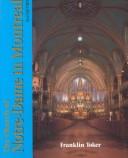
ISBN: 128352953X 9786613841988 0773585044 9780773585041 0773508481 9780773508484 Year: 1991 Publisher: Montreal Buffalo McGill-Queen's University Press
Abstract | Keywords | Export | Availability | Bookmark
 Loading...
Loading...Choose an application
- Reference Manager
- EndNote
- RefWorks (Direct export to RefWorks)
The construction of the Church of Notre-Dame was one of the boldest building projects of the nineteenth century. The first major example of Gothic Revival architecture in Canada, it was, at the time of its completion, the largest building in North America. Franklin Toker treats the church not only as a work of art but also as a historical document that reflected the social and nationalist aspirations of the community and marked a high point in the fascinating career of its architect, James O'Donnell.
Gothic revival (Architecture) --- Architecture, Gothic --- Gothic revival (Art) --- Architecture, Victorian --- O'Donnell, James, --- Criticism and interpretation. --- Notre-Dame de Montréal (Church) --- Montreal. --- Church of Notre Dame in Montreal --- Notre-Dame (Church : Montréal, Québec) --- Montréal (Québec) --- Manrėalʹ (Québec) --- Marianopolis (Québec) --- Mengteli'er (Québec) --- Monrealʹ (Québec) --- Monreāla (Québec) --- Monrealis (Québec) --- Mons Regalis (Québec) --- Mons Regius (Québec) --- Mont-Royal (Québec) --- Montoriōru (Québec) --- Montreali (Québec) --- Monṭreʼol (Québec) --- Montʻŭriol (Québec) --- Mūntiryāl (Québec) --- Ville de Montréal (Québec) --- Μόντρεαλ (Québec) --- Манрэаль (Québec) --- Монреал (Québec) --- Монреаль (Québec) --- Монтреал (Québec) --- מאנטרעאל (Québec) --- מונטריאול (Québec) --- مونتريال (Québec) --- モントリオール (Québec) --- 蒙特利尔 (Québec) --- 몬트리올 (Québec) --- Buildings, structures, etc.
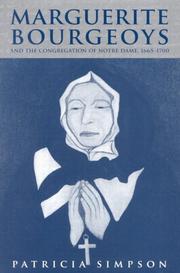
ISBN: 1282863800 9786612863806 0773573194 9780773573192 0773529705 9780773529700 9781282863804 6612863803 Year: 2005 Publisher: Montréal Ithaca McGill-Queen's University Press
Abstract | Keywords | Export | Availability | Bookmark
 Loading...
Loading...Choose an application
- Reference Manager
- EndNote
- RefWorks (Direct export to RefWorks)
Simpson shows that the order faced great resistance from the male church hierarchy despite the fact that the pioneer society depended on the work of the Congregation. The order was particularly important in assuming the guardianship of many filles du roi - young women sent to New France under royal auspices to be married to the men of the colony. Simpson also examines the many difficulties the Congregation faced, which included natural disasters and the dangers faced in trying to reach women and children in settlements throughout New France, as far away as Acadia.
Nuns --- Christian saints --- Saints --- Canonization --- Bourgeoys, Marguerite, --- Bourgeois, Marguerite, --- Sister of the Blessed Sacrament, --- Sœur du Saint Sacrement, --- Congregation of Notre-Dame --- CND (Congregation of Notre-Dame) --- History. --- Montréal (Québec) --- Manrėalʹ (Québec) --- Marianopolis (Québec) --- Mengteli'er (Québec) --- Monrealʹ (Québec) --- Monreāla (Québec) --- Monrealis (Québec) --- Mons Regalis (Québec) --- Mons Regius (Québec) --- Mont-Royal (Québec) --- Montoriōru (Québec) --- Montreali (Québec) --- Monṭreʼol (Québec) --- Montʻŭriol (Québec) --- Mūntiryāl (Québec) --- Ville de Montréal (Québec) --- Μόντρεαλ (Québec) --- Манрэаль (Québec) --- Монреал (Québec) --- Монреаль (Québec) --- Монтреал (Québec) --- מאנטרעאל (Québec) --- מונטריאול (Québec) --- مونتريال (Québec) --- モントリオール (Québec) --- 蒙特利尔 (Québec) --- 몬트리올 (Québec) --- Religion --- Religieuses --- Saints chrétiens --- Congrégation de Notre-Dame --- Histoire. --- Saints chretiens --- Congregation de Notre-Dame --- Montreal (Quebec)
Book
ISBN: 0773586008 9780773586000 9780773538306 0773538305 9780773538313 0773538313 Year: 2011 Publisher: Montreal [Que.] McGill-Queen's University Press
Abstract | Keywords | Export | Availability | Bookmark
 Loading...
Loading...Choose an application
- Reference Manager
- EndNote
- RefWorks (Direct export to RefWorks)
Benefiting from Montreal's remarkable archival records, Sherry Olson and Patricia Thornton use an ingenious sampling of twelve surnames to track the comings and goings, births, deaths, and marriages of the city's inhabitants. The book demonstrates the importance of individual decisions by outlining the circumstances in which people decided where to move, when to marry, and what work to do. Integrating social and spatial analysis, the authors provide insights into the relationships among the city's three cultural communities, show how inequalities of voice, purchasing power, and access to real property were maintained, and provide first-hand evidence of the impact of city living and poverty on families, health, and futures. The findings challenge presumptions about the cultural "assimilation" of migrants as well as our understanding of urban life in nineteenth-century North America. The culmination of twenty-five years of work, Peopling the North American City is an illuminating look at the humanity of cities and the elements that determine whether their citizens will thrive or merely survive.
City and town life --- Immigrant families --- Assimilation (Sociology) --- Cultural assimilation --- Anthropology --- Socialization --- Acculturation --- Cultural fusion --- Emigration and immigration --- Minorities --- Families of emigrants --- Families --- City life --- Town life --- Urban life --- Sociology, Urban --- History --- Montréal (Québec) --- Manrėalʹ (Québec) --- Marianopolis (Québec) --- Mengteli'er (Québec) --- Monrealʹ (Québec) --- Monreāla (Québec) --- Monrealis (Québec) --- Mons Regalis (Québec) --- Mons Regius (Québec) --- Mont-Royal (Québec) --- Montoriōru (Québec) --- Montreali (Québec) --- Monṭreʼol (Québec) --- Montʻŭriol (Québec) --- Mūntiryāl (Québec) --- Ville de Montréal (Québec) --- Μόντρεαλ (Québec) --- Манрэаль (Québec) --- Монреал (Québec) --- Монреаль (Québec) --- Монтреал (Québec) --- מאנטרעאל (Québec) --- מונטריאול (Québec) --- مونتريال (Québec) --- モントリオール (Québec) --- 蒙特利尔 (Québec) --- 몬트리올 (Québec) --- Ethnic relations --- Social life and customs --- Vie urbaine --- Familles immigrantes --- Montreal (Quebec) --- Assimilation (Sociologie) --- #SBIB:97G --- #SBIB:314H150 --- Histoire --- Relations interethniques --- Geschiedenis van Noord-Amerika --- Historische demografie en demografische historiek: algemeen --- Moeurs et coutumes
Book
ISBN: 1283834855 0773587551 9780773587557 9781283834858 9780773539327 0773539328 077358756X Year: 2012 Publisher: Montreal : McGill-Queen's University Press,
Abstract | Keywords | Export | Availability | Bookmark
 Loading...
Loading...Choose an application
- Reference Manager
- EndNote
- RefWorks (Direct export to RefWorks)
Powerless under the country's constitution, Canadian municipal governments often find themselves in conflict with their provincial masters. In 2002, the Province of Quebec forcibly merged all cities on the Island of Montreal into a single municipality - a decision that was partially reversed in 2006. The first book-length study of the series of mergers imposed by the Parti Québécois government, The Merger Delusion is a sharp and insightful critique by a key player in anti-merger politics. Peter Trent, mayor of the City of Westmount, Quebec, foresaw the numerous financial and institutional problems posed by amalgamating municipalities into megacities. Here, he presents a stirring and detailed account of the battle he led against the provincial government, the City of Montreal, the Board of Trade, and many of his former colleagues. Describing how he took the struggle all the way to the Supreme Court of Canada, Trent demonstrates the ways in which de-mergers resonated with voters and eventually helped the Quebec Liberal Party win the 2003 provincial election. As the cost and pitfalls of forced mergers become clearer in hindsight, The Merger Delusion recounts a compelling case study with broad implications for cities across the globe.
Annexation (Municipal government) --- Municipal annexation --- Cities and towns --- Local government --- Metropolitan areas --- Metropolitan government --- Municipal corporations --- Municipal government --- Municipal incorporation --- Growth --- Montréal (Québec) --- Manrėalʹ (Québec) --- Marianopolis (Québec) --- Mengteli'er (Québec) --- Monrealʹ (Québec) --- Monreāla (Québec) --- Monrealis (Québec) --- Mons Regalis (Québec) --- Mons Regius (Québec) --- Mont-Royal (Québec) --- Montoriōru (Québec) --- Montreali (Québec) --- Monṭreʼol (Québec) --- Montʻŭriol (Québec) --- Mūntiryāl (Québec) --- Ville de Montréal (Québec) --- Μόντρεαλ (Québec) --- Манрэаль (Québec) --- Монреал (Québec) --- Монреаль (Québec) --- Монтреал (Québec) --- מאנטרעאל (Québec) --- מונטריאול (Québec) --- مونتريال (Québec) --- モントリオール (Québec) --- 蒙特利尔 (Québec) --- 몬트리올 (Québec) --- Politics and government.
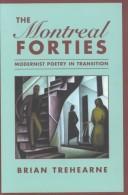
ISBN: 1282037129 9786612037122 1442681721 9781442681729 0802044522 9780802044525 1442613238 Year: 1999 Publisher: Toronto
Abstract | Keywords | Export | Availability | Bookmark
 Loading...
Loading...Choose an application
- Reference Manager
- EndNote
- RefWorks (Direct export to RefWorks)
During WWII, a number of Canadian poets converged on Montreal and rewrote the story of modern English-Canadian poetry. The book discusses the four major English-Canadian poets to emerge in the 40s; PK Page, AM Klein, Irving Layton and Louis Dudek.
Modernism (Literature) --- LITERARY CRITICISM / Canadian. --- Crepuscolarismo --- Literary movements --- Page, P. K. --- Klein, A. M. --- Layton, Irving, --- Dudek, Louis, --- Lazarovitch, Israel, --- Lazarovitch, Irving Peter, --- Klein, Abraham Moses, --- Page, Patricia Kathleen, --- Cape, Judith, --- Irwin, P. K., --- Criticism and interpretation. --- Montréal (Québec) --- Intellectual life --- Manrėalʹ (Québec) --- Marianopolis (Québec) --- Mengteli'er (Québec) --- Monrealʹ (Québec) --- Monreāla (Québec) --- Monrealis (Québec) --- Mons Regalis (Québec) --- Mons Regius (Québec) --- Mont-Royal (Québec) --- Montoriōru (Québec) --- Montreali (Québec) --- Monṭreʼol (Québec) --- Montʻŭriol (Québec) --- Mūntiryāl (Québec) --- Ville de Montréal (Québec) --- Μόντρεαλ (Québec) --- Манрэаль (Québec) --- Монреал (Québec) --- Монреаль (Québec) --- Монтреал (Québec) --- מאנטרעאל (Québec) --- מונטריאול (Québec) --- مونتريال (Québec) --- モントリオール (Québec) --- 蒙特利尔 (Québec) --- 몬트리올 (Québec)
Book
ISBN: 077358403X 9780773584037 9780773584099 0773584099 0773545379 9780773545373 0773545387 9780773545380 Year: 2015 Publisher: Montreal Kingston London Ithaca
Abstract | Keywords | Export | Availability | Bookmark
 Loading...
Loading...Choose an application
- Reference Manager
- EndNote
- RefWorks (Direct export to RefWorks)
A new analysis of the factors and human choice at the heart of industrialization and social change.
Industrialization --- Industrial revolution --- Revolution, Industrial --- Economic history --- Social history --- Industrial development --- Economic development --- Economic policy --- Deindustrialization --- History. --- Social aspects --- Montréal (Québec) --- Manrėalʹ (Québec) --- Marianopolis (Québec) --- Mengteli'er (Québec) --- Monrealʹ (Québec) --- Monreāla (Québec) --- Monrealis (Québec) --- Mons Regalis (Québec) --- Mons Regius (Québec) --- Mont-Royal (Québec) --- Montoriōru (Québec) --- Montreali (Québec) --- Monṭreʼol (Québec) --- Montʻŭriol (Québec) --- Mūntiryāl (Québec) --- Ville de Montréal (Québec) --- Μόντρεαλ (Québec) --- Манрэаль (Québec) --- Монреал (Québec) --- Монреаль (Québec) --- Монтреал (Québec) --- מאנטרעאל (Québec) --- מונטריאול (Québec) --- مونتريال (Québec) --- モントリオール (Québec) --- 蒙特利尔 (Québec) --- 몬트리올 (Québec) --- Economic conditions --- 1800-1899
| Listing 1 - 10 of 16 | << page >> |
Sort by
|

 Search
Search Feedback
Feedback About UniCat
About UniCat  Help
Help News
News